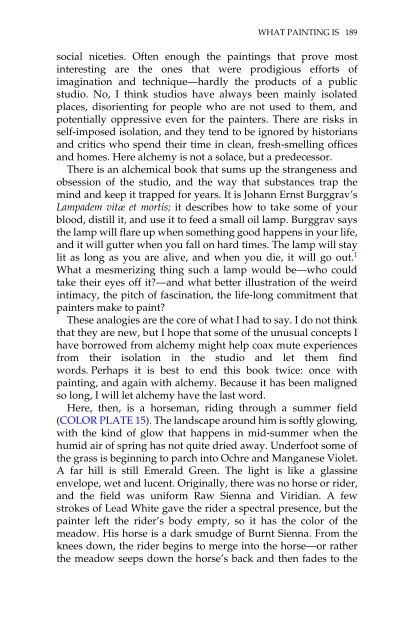What Painting Is: How to Think about Oil Painting ... - Victoria Vesna
What Painting Is: How to Think about Oil Painting ... - Victoria Vesna
What Painting Is: How to Think about Oil Painting ... - Victoria Vesna
You also want an ePaper? Increase the reach of your titles
YUMPU automatically turns print PDFs into web optimized ePapers that Google loves.
WHAT PAINTING IS 189<br />
social niceties. Often enough the paintings that prove most<br />
interesting are the ones that were prodigious efforts of<br />
imagination and technique—hardly the products of a public<br />
studio. No, I think studios have always been mainly isolated<br />
places, disorienting for people who are not used <strong>to</strong> them, and<br />
potentially oppressive even for the painters. There are risks in<br />
self-imposed isolation, and they tend <strong>to</strong> be ignored by his<strong>to</strong>rians<br />
and critics who spend their time in clean, fresh-smelling offices<br />
and homes. Here alchemy is not a solace, but a predecessor.<br />
There is an alchemical book that sums up the strangeness and<br />
obsession of the studio, and the way that substances trap the<br />
mind and keep it trapped for years. It is Johann Ernst Burggrav’s<br />
Lampadem vitæ et mortis; it describes how <strong>to</strong> take some of your<br />
blood, distill it, and use it <strong>to</strong> feed a small oil lamp. Burggrav says<br />
the lamp will flare up when something good happens in your life,<br />
and it will gutter when you fall on hard times. The lamp will stay<br />
lit as long as you are alive, and when you die, it will go out. 1<br />
<strong>What</strong> a mesmerizing thing such a lamp would be—who could<br />
take their eyes off it?—and what better illustration of the weird<br />
intimacy, the pitch of fascination, the life-long commitment that<br />
painters make <strong>to</strong> paint?<br />
These analogies are the core of what I had <strong>to</strong> say. I do not think<br />
that they are new, but I hope that some of the unusual concepts I<br />
have borrowed from alchemy might help coax mute experiences<br />
from their isolation in the studio and let them find<br />
words. Perhaps it is best <strong>to</strong> end this book twice: once with<br />
painting, and again with alchemy. Because it has been maligned<br />
so long, I will let alchemy have the last word.<br />
Here, then, is a horseman, riding through a summer field<br />
(COLOR PLATE 15). The landscape around him is softly glowing,<br />
with the kind of glow that happens in mid-summer when the<br />
humid air of spring has not quite dried away. Underfoot some of<br />
the grass is beginning <strong>to</strong> parch in<strong>to</strong> Ochre and Manganese Violet.<br />
A far hill is still Emerald Green. The light is like a glassine<br />
envelope, wet and lucent. Originally, there was no horse or rider,<br />
and the field was uniform Raw Sienna and Viridian. A few<br />
strokes of Lead White gave the rider a spectral presence, but the<br />
painter left the rider’s body empty, so it has the color of the<br />
meadow. His horse is a dark smudge of Burnt Sienna. From the<br />
knees down, the rider begins <strong>to</strong> merge in<strong>to</strong> the horse—or rather<br />
the meadow seeps down the horse’s back and then fades <strong>to</strong> the


